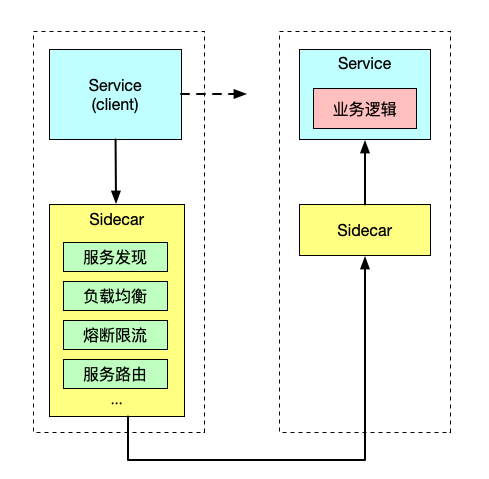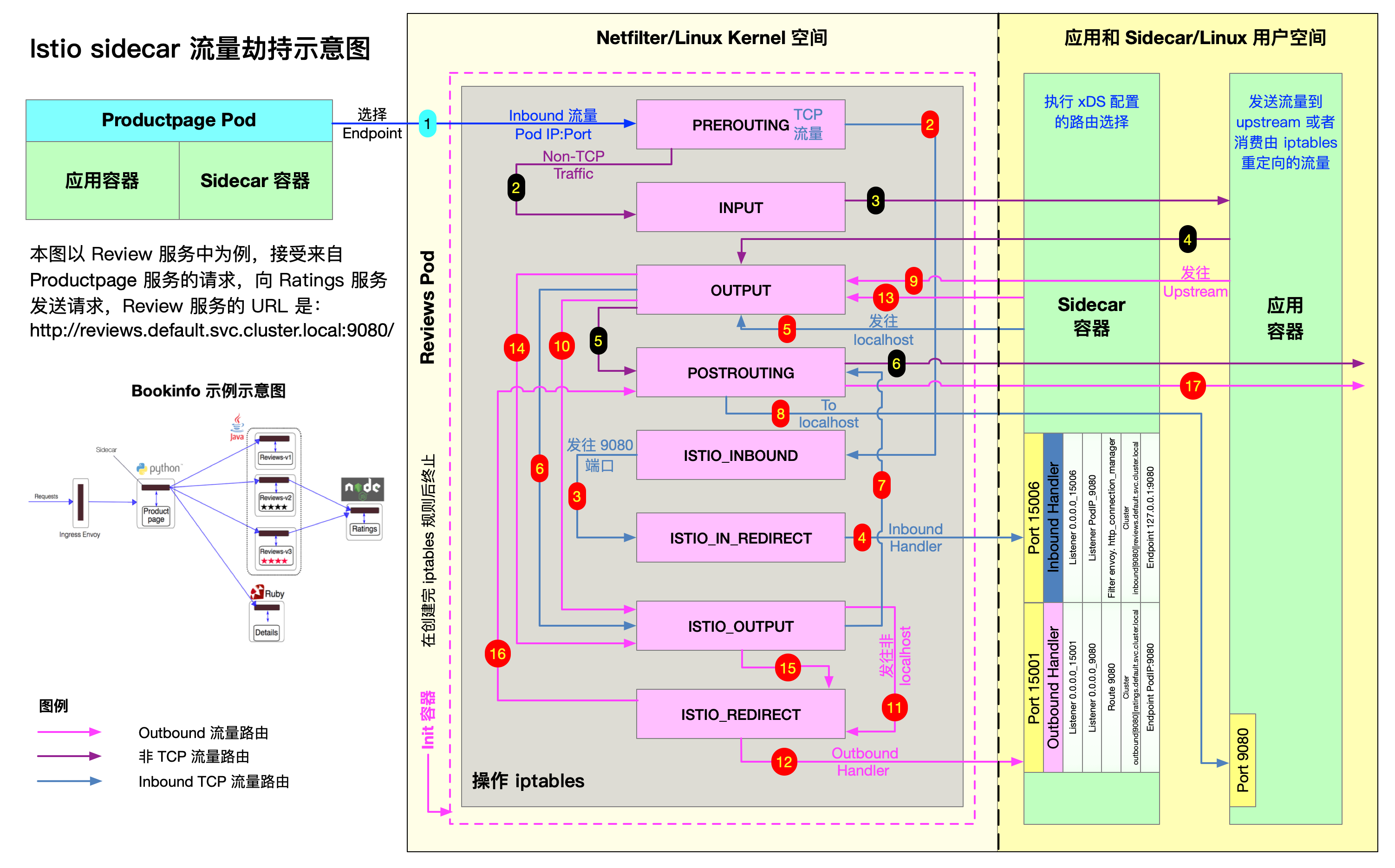Sidecar 注入及透明流量劫持
本节将为大家介绍以下内容:
Sidecar 模式
将应用程序的功能划分为单独的进程运行在同一个最小调度单元中(例如 Kubernetes 中的 Pod)可以被视为 sidecar 模式。如下图所示,sidecar 模式允许您在应用程序旁边添加更多功能,而无需额外第三方组件配置或修改应用程序代码。

就像连接了 Sidecar 的三轮摩托车一样,在软件架构中, Sidecar 连接到父应用并且为其添加扩展或者增强功能。Sidecar 应用与主应用程序松散耦合。它可以屏蔽不同编程语言的差异,统一实现微服务的可观察性、监控、日志记录、配置、断路器等功能。
使用 Sidecar 模式的优势
使用 sidecar 模式部署服务网格时,无需在节点上运行代理,但是集群中将运行多个相同的 sidecar 副本。在 sidecar 部署方式中,每个应用的容器旁都会部署一个伴生容器(如 Envoy 或 MOSN),这个容器称之为 sidecar 容器。Sidecar 接管进出应用容器的所有流量。在 Kubernetes 的 Pod 中,在原有的应用容器旁边注入一个 Sidecar 容器,两个容器共享存储、网络等资源,可以广义的将这个包含了 sidecar 容器的 Pod 理解为一台主机,两个容器共享主机资源。
因其独特的部署结构,使得 sidecar 模式具有以下优势:
- 将与应用业务逻辑无关的功能抽象到共同基础设施,降低了微服务代码的复杂度。
- 因为不再需要编写相同的第三方组件配置文件和代码,所以能够降低微服务架构中的代码重复度。
- Sidecar 可独立升级,降低应用程序代码和底层平台的耦合度。
Istio 中的 sidecar 注入
- 使用
istioctl手动注入。 - 基于 Kubernetes 的 突变 webhook 入驻控制器(mutating webhook addmission controller 的自动 sidecar 注入方式。
不论是手动注入还是自动注入,sidecar 的注入过程都需要遵循如下步骤:
- Kubernetes 需要了解待注入的 sidecar 所连接的 Istio 集群及其配置;
- Kubernetes 需要了解待注入的 sidecar 容器本身的配置,如镜像地址、启动参数等;
- Kubernetes 根据 sidecar 注入模板和以上配置填充 sidecar 的配置参数,将以上配置注入到应用容器的一侧;
使用下面的命令可以手动注入 sidecar。
istioctl kube-inject -f ${YAML_FILE} | kuebectl apply -f -
该命令会使用 Istio 内置的 sidecar 配置来注入,下面使用 Istio详细配置请参考 Istio 官网。
注入完成后您将看到 Istio 为原有 pod template 注入了 initContainer 及 sidecar proxy相关的配置。
Init 容器
Init 容器是一种专用容器,它在应用程序容器启动之前运行,用来包含一些应用镜像中不存在的实用工具或安装脚本。
一个 Pod 中可以指定多个 Init 容器,如果指定了多个,那么 Init 容器将会按顺序依次运行。只有当前面的 Init 容器必须运行成功后,才可以运行下一个 Init 容器。当所有的 Init 容器运行完成后,Kubernetes 才初始化 Pod 和运行应用容器。
Init 容器使用 Linux Namespace,所以相对应用程序容器来说具有不同的文件系统视图。因此,它们能够具有访问 Secret 的权限,而应用程序容器则不能。
在 Pod 启动过程中,Init 容器会按顺序在网络和数据卷初始化之后启动。每个容器必须在下一个容器启动之前成功退出。如果由于运行时或失败退出,将导致容器启动失败,它会根据 Pod 的 restartPolicy 指定的策略进行重试。然而,如果 Pod 的 restartPolicy 设置为 Always,Init 容器失败时会使用 RestartPolicy 策略。
在所有的 Init 容器没有成功之前,Pod 将不会变成 Ready 状态。Init 容器的端口将不会在 Service 中进行聚集。 正在初始化中的 Pod 处于 Pending 状态,但应该会将 Initializing 状态设置为 true。Init 容器运行完成以后就会自动终止。
关于 Init 容器的详细信息请参考 Init 容器 - Kubernetes 中文指南/云原生应用架构实践手册。
Sidecar 注入示例分析
以 Istio 官方提供的 bookinfo 中 productpage 的 YAML 为例,关于 bookinfo 应用的详细 YAML 配置请参考 bookinfo.yaml。
下文将从以下几个方面讲解:
- Sidecar 容器的注入
- iptables 规则的创建
- 路由的详细过程
apiVersion: apps/v1
kind: Deployment
metadata:
name: productpage-v1
labels:
app: productpage
version: v1
spec:
replicas: 1
selector:
matchLabels:
app: productpage
version: v1
template:
metadata:
labels:
app: productpage
version: v1
spec:
serviceAccountName: bookinfo-productpage
containers:
- name: productpage
image: docker.io/istio/examples-bookinfo-productpage-v1:1.15.0
imagePullPolicy: IfNotPresent
ports:
- containerPort: 9080
volumeMounts:
- name: tmp
mountPath: /tmp
volumes:
- name: tmp
emptyDir: {}
再查看下 productpage 容器的 Dockerfile。
FROM python:3.7.4-slim
COPY requirements.txt ./
RUN pip install --no-cache-dir -r requirements.txt
COPY test-requirements.txt ./
RUN pip install --no-cache-dir -r test-requirements.txt
COPY productpage.py /opt/microservices/
COPY tests/unit/* /opt/microservices/
COPY templates /opt/microservices/templates
COPY static /opt/microservices/static
COPY requirements.txt /opt/microservices/
ARG flood_factor
ENV FLOOD_FACTOR ${flood_factor:-0}
EXPOSE 9080
WORKDIR /opt/microservices
RUN python -m unittest discover
USER 1
CMD ["python", "productpage.py", "9080"]
我们看到 Dockerfile 中没有配置 ENTRYPOINT,所以 CMD 的配置 python productpage.py 9080 将作为默认的 ENTRYPOINT,记住这一点,再看下注入 sidecar 之后的配置。
$ istioctl kube-inject -f samples/bookinfo/platform/kube/bookinfo.yaml
我们只截取其中与 productpage 相关的 Deployment 配置中的部分 YAML 配置。
containers:
- image: docker.io/istio/examples-bookinfo-productpage-v1:1.15.0 # 应用镜像
name: productpage
ports:
- containerPort: 9080
- args:
- proxy
- sidecar
- --domain
- $(POD_NAMESPACE).svc.cluster.local
- --configPath
- /etc/istio/proxy
- --binaryPath
- /usr/local/bin/envoy
- --serviceCluster
- productpage.$(POD_NAMESPACE)
- --drainDuration
- 45s
- --parentShutdownDuration
- 1m0s
- --discoveryAddress
- istiod.istio-system.svc:15012
- --zipkinAddress
- zipkin.istio-system:9411
- --proxyLogLevel=warning
- --proxyComponentLogLevel=misc:error
- --connectTimeout
- 10s
- --proxyAdminPort
- "15000"
- --concurrency
- "2"
- --controlPlaneAuthPolicy
- NONE
- --dnsRefreshRate
- 300s
- --statusPort
- "15020"
- --trust-domain=cluster.local
- --controlPlaneBootstrap=false
image: docker.io/istio/proxyv2:1.5.1 # sidecar proxy
name: istio-proxy
ports:
- containerPort: 15090
name: http-envoy-prom
protocol: TCP
initContainers:
- command:
- istio-iptables
- -p
- "15001"
- -z
- "15006"
- -u
- "1337"
- -m
- REDIRECT
- -i
- '*'
- -x
- ""
- -b
- '*'
- -d
- 15090,15020
image: docker.io/istio/proxyv2:1.5.1 # init 容器
name: istio-init
接下来将分别解析下这两个容器。
Init 容器解析
Istio 在 pod 中注入的 Init 容器名为 istio-init,我们在上面 Istio 注入完成后的 YAML 文件中看到了该容器的启动命令是:
istio-iptables -p 15001 -z 15006 -u 1337 -m REDIRECT -i '*' -x "" -b '*' -d 15090,15020
我们再检查下该容器的 Dockerfile 看看 ENTRYPOINT 是怎么确定启动时执行的命令。
# 前面的内容省略
# The pilot-agent will bootstrap Envoy.
ENTRYPOINT ["/usr/local/bin/pilot-agent"]
我们看到 istio-init 容器的入口是 /usr/local/bin/istio-iptables 命令行,该命令行工具的代码的位置在 Istio 源码仓库的 tools/istio-iptables 目录。
注意:在 Istio 1.1 版本时还是使用 isito-iptables.sh 命令行来操作 IPtables。
Init 容器启动入口
Init 容器的启动入口是 istio-iptables 命令行,该命令行工具的用法如下:
$ istio-iptables [flags]
-p: 指定重定向所有 TCP 流量的 sidecar 端口(默认为 $ENVOY_PORT = 15001)
-m: 指定入站连接重定向到 sidecar 的模式,“REDIRECT” 或 “TPROXY”(默认为 $ISTIO_INBOUND_INTERCEPTION_MODE)
-b: 逗号分隔的入站端口列表,其流量将重定向到 Envoy(可选)。使用通配符 “*” 表示重定向所有端口。为空时表示禁用所有入站重定向(默认为 $ISTIO_INBOUND_PORTS)
-d: 指定要从重定向到 sidecar 中排除的入站端口列表(可选),以逗号格式分隔。使用通配符“*” 表示重定向所有入站流量(默认为 $ISTIO_LOCAL_EXCLUDE_PORTS)
-o:逗号分隔的出站端口列表,不包括重定向到 Envoy 的端口。
-i: 指定重定向到 sidecar 的 IP 地址范围(可选),以逗号分隔的 CIDR 格式列表。使用通配符 “*” 表示重定向所有出站流量。空列表将禁用所有出站重定向(默认为 $ISTIO_SERVICE_CIDR)
-x: 指定将从重定向中排除的 IP 地址范围,以逗号分隔的 CIDR 格式列表。使用通配符 “*” 表示重定向所有出站流量(默认为 $ISTIO_SERVICE_EXCLUDE_CIDR)。
-k:逗号分隔的虚拟接口列表,其入站流量(来自虚拟机的)将被视为出站流量。
-g:指定不应用重定向的用户的 GID。(默认值与 -u param 相同)
-u:指定不应用重定向的用户的 UID。通常情况下,这是代理容器的 UID(默认值是 1337,即 istio-proxy 的 UID)。
-z: 所有进入 pod/VM 的 TCP 流量应被重定向到的端口(默认 $INBOUND_CAPTURE_PORT = 15006)。
以上传入的参数都会重新组装成 iptables 规则,关于该命令的详细用法请访问 tools/istio-iptables/pkg/cmd/root.go。
该容器存在的意义就是让 sidecar 代理可以拦截所有的进出 pod 的流量,15090 端口(Mixer 使用)和 15092 端口(Ingress Gateway)除外的所有入站(inbound)流量重定向到 15006 端口(sidecar),再拦截应用容器的出站(outbound)流量经过 sidecar 处理(通过 15001 端口监听)后再出站。关于 Istio 中端口用途请参考 Istio 官方文档。
命令解析
这条启动命令的作用是:
- 将应用容器的所有流量都转发到 sidecar 的 15006 端口。
- 使用
istio-proxy用户身份运行, UID 为 1337,即 sidecar 所处的用户空间,这也是istio-proxy容器默认使用的用户,见 YAML 配置中的runAsUser字段。 - 使用默认的
REDIRECT模式来重定向流量。 - 将所有出站流量都重定向到 sidecar 代理(通过 15001 端口)。
因为 Init 容器初始化完毕后就会自动终止,因为我们无法登陆到容器中查看 iptables 信息,但是 Init 容器初始化结果会保留到应用容器和 sidecar 容器中。
iptables 注入解析
为了查看 iptables 配置,我们需要登陆到 sidecar 容器中使用 root 用户来查看,因为 kubectl 无法使用特权模式来远程操作 docker 容器,所以我们需要登陆到 productpage pod 所在的主机上使用 docker 命令登陆容器中查看。
如果您使用 minikube 部署的 Kubernetes,可以直接登录到 minikube 的虚拟机中并切换为 root 用户。查看 iptables 配置,列出 NAT(网络地址转换)表的所有规则,因为在 Init 容器启动的时候选择给 istio-iptables 传递的参数中指定将入站流量重定向到 sidecar 的模式为 REDIRECT,因此在 iptables 中将只有 NAT 表的规格配置,如果选择 TPROXY 还会有 mangle 表配置。iptables 命令的详细用法请参考 iptables,规则配置请参考 iptables 规则配置。
我们仅查看与 productpage 有关的 iptables 规则如下。
# 进入 minikube 并切换为 root 用户,minikube 默认用户为 docker
$ minikube ssh
$ sudo -i
# 查看 productpage pod 的 istio-proxy 容器中的进程
$ docker top `docker ps|grep "istio-proxy_productpage"|cut -d " " -f1`
UID PID PPID C STIME TTY TIME CMD
1337 10576 10517 0 08:09 ? 00:00:07 /usr/local/bin/pilot-agent proxy sidecar --domain default.svc.cluster.local --configPath /etc/istio/proxy --binaryPath /usr/local/bin/envoy --serviceCluster productpage.default --drainDuration 45s --parentShutdownDuration 1m0s --discoveryAddress istiod.istio-system.svc:15012 --zipkinAddress zipkin.istio-system:9411 --proxyLogLevel=warning --proxyComponentLogLevel=misc:error --connectTimeout 10s --proxyAdminPort 15000 --concurrency 2 --controlPlaneAuthPolicy NONE --dnsRefreshRate 300s --statusPort 15020 --trust-domain=cluster.local --controlPlaneBootstrap=false
1337 10660 10576 0 08:09 ? 00:00:33 /usr/local/bin/envoy -c /etc/istio/proxy/envoy-rev0.json --restart-epoch 0 --drain-time-s 45 --parent-shutdown-time-s 60 --service-cluster productpage.default --service-node sidecar~172.17.0.16~productpage-v1-7f44c4d57c-ksf9b.default~default.svc.cluster.local --max-obj-name-len 189 --local-address-ip-version v4 --log-format [Envoy (Epoch 0)] [%Y-%m-%d %T.%e][%t][%l][%n] %v -l warning --component-log-level misc:error --concurrency 2
# 进入 nsenter 进入 sidecar 容器的命名空间(以上任何一个都可以)
$ nsenter -n --target 10660
在该进程的命名空间下查看其 iptables 规则链。
# 查看 NAT 表中规则配置的详细信息。
$ iptables -t nat -L -v
# PREROUTING 链:用于目标地址转换(DNAT),将所有入站 TCP 流量跳转到 ISTIO_INBOUND 链上。
Chain PREROUTING (policy ACCEPT 2701 packets, 162K bytes)
pkts bytes target prot opt in out source destination
2701 162K ISTIO_INBOUND tcp -- any any anywhere anywhere
# INPUT 链:处理输入数据包,非 TCP 流量将继续 OUTPUT 链。
Chain INPUT (policy ACCEPT 2701 packets, 162K bytes)
pkts bytes target prot opt in out source destination
# OUTPUT 链:将所有出站数据包跳转到 ISTIO_OUTPUT 链上。
Chain OUTPUT (policy ACCEPT 79 packets, 6761 bytes)
pkts bytes target prot opt in out source destination
15 900 ISTIO_OUTPUT tcp -- any any anywhere anywhere
# POSTROUTING 链:所有数据包流出网卡时都要先进入POSTROUTING 链,内核根据数据包目的地判断是否需要转发出去,我们看到此处未做任何处理。
Chain POSTROUTING (policy ACCEPT 79 packets, 6761 bytes)
pkts bytes target prot opt in out source destination
# ISTIO_INBOUND 链:将所有入站流量重定向到 ISTIO_IN_REDIRECT 链上,目的地为 15090(mixer 使用)和 15020(Ingress gateway 使用,用于 Pilot 健康检查)端口的流量除外,发送到以上两个端口的流量将返回 iptables 规则链的调用点,即 PREROUTING 链的后继 POSTROUTING。
Chain ISTIO_INBOUND (1 references)
pkts bytes target prot opt in out source destination
0 0 RETURN tcp -- any any anywhere anywhere tcp dpt:ssh
2 120 RETURN tcp -- any any anywhere anywhere tcp dpt:15090
2699 162K RETURN tcp -- any any anywhere anywhere tcp dpt:15020
0 0 ISTIO_IN_REDIRECT tcp -- any any anywhere anywhere
# ISTIO_IN_REDIRECT 链:将所有的入站流量跳转到本地的 15006 端口,至此成功的拦截了流量到 sidecar 中。
Chain ISTIO_IN_REDIRECT (3 references)
pkts bytes target prot opt in out source destination
0 0 REDIRECT tcp -- any any anywhere anywhere redir ports 15006
# ISTIO_OUTPUT 链:选择需要重定向到 Envoy(即本地) 的出站流量,所有非 localhost 的流量全部转发到 ISTIO_REDIRECT。为了避免流量在该 Pod 中无限循环,所有到 istio-proxy 用户空间的流量都返回到它的调用点中的下一条规则,本例中即 OUTPUT 链,因为跳出 ISTIO_OUTPUT 规则之后就进入下一条链 POSTROUTING。如果目的地非 localhost 就跳转到 ISTIO_REDIRECT;如果流量是来自 istio-proxy 用户空间的,那么就跳出该链,返回它的调用链继续执行下一条规则(OUTPUT 的下一条规则,无需对流量进行处理);所有的非 istio-proxy 用户空间的目的地是 localhost 的流量就跳转到 ISTIO_REDIRECT。
Chain ISTIO_OUTPUT (1 references)
pkts bytes target prot opt in out source destination
0 0 RETURN all -- any lo 127.0.0.6 anywhere
0 0 ISTIO_IN_REDIRECT all -- any lo anywhere !localhost owner UID match 1337
0 0 RETURN all -- any lo anywhere anywhere ! owner UID match 1337
15 900 RETURN all -- any any anywhere anywhere owner UID match 1337
0 0 ISTIO_IN_REDIRECT all -- any lo anywhere !localhost owner GID match 1337
0 0 RETURN all -- any lo anywhere anywhere ! owner GID match 1337
0 0 RETURN all -- any any anywhere anywhere owner GID match 1337
0 0 RETURN all -- any any anywhere localhost
0 0 ISTIO_REDIRECT all -- any any anywhere anywhere
# ISTIO_REDIRECT 链:将所有流量重定向到 Sidecar(即本地) 的 15001 端口。
Chain ISTIO_REDIRECT (1 references)
pkts bytes target prot opt in out source destination
0 0 REDIRECT tcp -- any any anywhere anywhere redir ports 15001
下图展示的是 productpage 服务请求访问 http://reviews.default.svc.cluster.local:9080/,当流量进入 reviews 服务内部时,reviews 服务内部的 sidecar proxy 是如何做流量拦截和路由转发的。

第一步开始时,productpage Pod 中的 sidecar 已经通过 EDS 选择出了要请求的 reviews 服务的一个 Pod,知晓了其 IP 地址,发送 TCP 连接请求。
reviews 服务有三个版本,每个版本有一个实例,三个版本中的 sidecar 工作步骤类似,关于 sidecar proxy 是如何做流量路由的请参阅本书流量路由章节。
小结
本节使用了 Istio 官方提供的 bookinfo 示例,按图索骥得带领读者了解了 sidecar 注入、iptables 透明流量劫持背后的实现细节。Sidecar 模式和流量透明劫持是 Istio 服务网格的特色和基础功能,理解该功能的背后过程及实现细节,将有助于大家理解 service mesh 的原理和本书后面章节中的内容,因此希望读者可以在自己的环境中从头来试验一遍以加深理解。